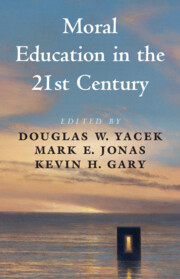Book contents
- Moral Education in the 21st Century
- Moral Education in the 21st Century
- Copyright page
- Contents
- Contributors
- Acknowledgments
- Chapter 1 Why Does Moral Education Matter in the 21st Century?
- Part I Historical Insights for Contemporary Moral Education
- Part II New Approaches to Moral Education
- Chapter 7 Liberal Authority and Moral Education
- Chapter 8 The Capability Approach as a Foundation for Moral Education
- Chapter 9 Recognition Theory and Moral Education
- Chapter 10 Practicing Care Ethics in the Current Context
- Chapter 11 A Non-Ideal Virtue Theory and the Centrality of Education
- Chapter 12 Pragmatist Moral Education
- Part III Responses to Contemporary Moral Problems
- Index
- References
Chapter 9 - Recognition Theory and Moral Education
from Part II - New Approaches to Moral Education
Published online by Cambridge University Press: 01 June 2023
- Moral Education in the 21st Century
- Moral Education in the 21st Century
- Copyright page
- Contents
- Contributors
- Acknowledgments
- Chapter 1 Why Does Moral Education Matter in the 21st Century?
- Part I Historical Insights for Contemporary Moral Education
- Part II New Approaches to Moral Education
- Chapter 7 Liberal Authority and Moral Education
- Chapter 8 The Capability Approach as a Foundation for Moral Education
- Chapter 9 Recognition Theory and Moral Education
- Chapter 10 Practicing Care Ethics in the Current Context
- Chapter 11 A Non-Ideal Virtue Theory and the Centrality of Education
- Chapter 12 Pragmatist Moral Education
- Part III Responses to Contemporary Moral Problems
- Index
- References
Summary
The theme of recognition is one of the most intensively discussed topics in the humanities and social sciences in the last decades. This chapter discusses its relevance for moral education. We begin with two examples illustrating lack of recognition in the school class, one concerning cultural difference and the other economic and social inequality. Secondly, we introduce the idea of recognition, its importance for individual and social life and some basic ways to think about its various forms. Thirdly, we discuss some specificities of school education that are necessary to bear in mind when applying the concept of recognition in this context. Finally, we tie these conceptual and theoretical considerations back to the two examples and show how a recognition-theoretical perspective can helpfully illuminate them. The conclusion summarizes our most important findings.
Keywords
- Type
- Chapter
- Information
- Moral Education in the 21st Century , pp. 151 - 170Publisher: Cambridge University PressPrint publication year: 2023



